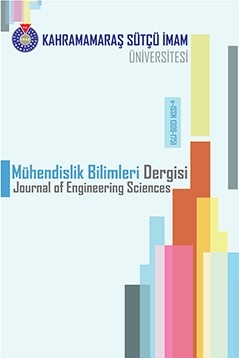Farklı İşletim Koşulları Altında Tiyosülfat Bazlı Ototrofik ve Miksotrofik Denitrifikasyon Performansının Araştırılması
Döngü süresi, Miksotrofik denitrifikasyon, S2O3-2/NO3- oranı, Ototrofik denitrifikasyon, Tiyosülfat
Evaluation of Thiosulfate-Based Autotrophic and Mixotrophic Denitrification Performances under Different Operational Conditions
Cycle time, Mixotrophic denitrification, S2O3-2/NO3- ratio, Autotrophic denitrification, Thiosulfate,
___
- Beller, H.R. (2005) “Anaerobic, nitrate-dependent oxidation of U(IV) oxide minerals by the chemolitotrophic bacterium Thiobacillusdenitrificans”, Appl. Environ. Microb., 71, 2170-2174.
- Campos, J. L.,Carvalho, S., Portela, R., Mosquera-Corral, A., &Méndez, R. (2008). Kinetics of denitrificationusingsulphurcompounds: effects of S/N ratio, endogenousandexogenouscompounds. Bioresourcetechnology, 99(5), 1293-1299.
- Guo, Y.,Guo, L., Sun, M., Zhao, Y., Gao, M., &She, Z. (2017). Effects of hydraulicretention time (HRT) on denitrificationusingwasteactivatedsludgethermalhydrolysisliquidandacidogenicliquid as carbonsources. Bioresourcetechnology, 224, 147-156.
- Liu, H., Jiang, W., Wan, D., Qu, J. (2009) “Study of a combined heterotrophicand sulfur autotrophic denitrification technology for removal of nitrate in water”, Journal of Haz Mat, 169, 23-28.
- Manconi, I., Carucci, A., Lens, P. (2007) “Combined removal of sulfur compound sand nitrate by autotrophic denitrification in bioaugmented activated sludge system”, Biotechnology and Bioengineering, 98 (3), 551-560.
- Moon, H.S., Shin, D.Y., Nam, K., Kim, J.Y. (2008) “A long-term performance test on an autotrophic denitrification column for application as a permeable reactive barrier”, Chemosphere, 73, 723-728.
- Oh, S.E., Yoo, Y.B., Young, J.C., Kim, I.S. (2001) “Effect of organics on sulfur-utilizing autotrophic denitrification under mixotrophic conditions”, J Biotechnol, 92,1-8.
- Sahinkaya, E.,&Kilic, A. (2014). Heterotrophicandelemental-sulfur-basedautotrophicdenitrificationprocessesforsimultaneousnitrateand Cr (VI) reduction. waterresearch, 50, 278-286.
- Sahinkaya, E., Dursun, N., Kilic, A., Demirel, S., Uyanik, S., Cinar, O. (2011) “Simultaneous heterotrophic and sulfur-oxidizing autotrophic denitrification process for drinking water treatment: Control of sulfate production”, Water Res., 45(20), 6661-6667.
- Sahinkaya, E., Kilic, A., Calimlioglu, B., &Toker, Y. (2013). Simultaneous bioreduction of nitrate and chromate using sulfur-based mixotrophic denitrification process. Journal of hazardous materials, 262, 234-239.
- Sahinkaya, E., Dursun, N. (2012) “Sulfur-oxidizing autotrophic and mixotrophic denitrification processes for drinking water treatment: elimination of excess sulfate production and alkalinity requirement”,Chemosphere, 89(2), 144-149.
- Sierra-Alvarez, R., Beristan-Cardoso, R., Salazar, M., Gomez, J., Razo-Flores, E., Field, J.A. (2007) “Chemolithotrophic denitrification with elemental sulfur for ground water Treatment”, Water Res, 41,1253-1262.
- Soares, M.I.M. (2000) “Biological denitrification of ground water”, Water, Air, Soil Poll., 123, 183-193.
- Soares, M.I.M. (2002) “Denitrification of ground water with elemental sulfur”, Water Res., 36, 1392-1395. Zhao, Y., Feng, C., Wang, Q., Yang, Y., Zhang, Z., &Sugiura, N. (2011). Nitrate removal from groundwater by cooperating heterotrophic with autotrophic denitrification in a biofilm–electrode reactor. Journal of Hazardous Materials, 192(3), 1033-1039.
- Başlangıç: 1998
- Yayıncı: Kahramanmaraş Sütçü İmam Üniversitesi
Edirne –Kırklareli /Trakya Yöresi sondajlarında mikropaleontolojik ve paleoortamsal yorumlar
Akü Cüruflarının Killerle İmmobilizasyonu: Full Faktoriyel Dizayn Analiz
Sığ Yeraltı Sularında Çoklu Zamansal Çözünürlük Veriler Kullanılarak Su Bütçesi Analizi
Mehmet UNSAL, Muhammet Ömer DİŞ, Emmanouil. N. ANAGNOSTOU
TURAB SELÇUK, Nagihan Bilal, Selman Sarıca, Batuhan AKBEN, Ahmet ALKAN
Mahmut Altun, Yunus CELİK, Mahit GÜNEŞ
PSO Algoritması ile Optimize Edilmiş PID Denetleyicinin Fotovoltaik MPPT Sistemine Uyarlanması
Osman DOĞMUŞ, Erdal KILIC, Sami ŞİT, Mahit GÜNEŞ
Uyku İğciğinin Yapay Sinir Ağları ve Morfolojik Filtreler Kullanılarak Tespit Edilmesi
Osman Aydoğan, Ali Öter, Osman Doğmuş, Kerim Güney
Konduit İle Venturili Konduitin Havalandırma Performansının Karşılaştırılması
